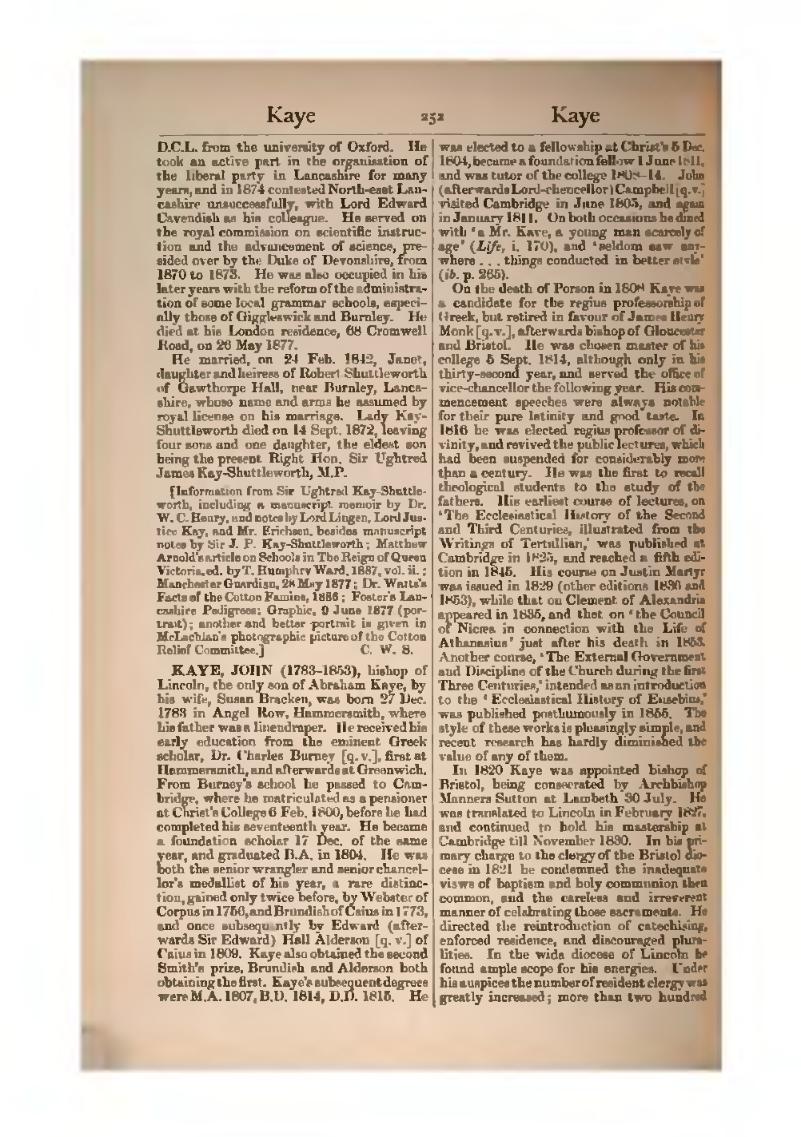D.C.L. from the university of Oxford. He took an active part in the organisation of the liberal party in Lancashire for many years, and in 1874 contested North-east Lancashire unsuccessfully, with Lord Edward Cavendish as his colleague. He served on the royal commission on scientific instruction and the advancement of science, presided over by the Duke of Devonshire, from 1870 to 1873. He was also occupied in his later years with the reform of the administration of some local grammar schools, especially those of Giggleswick and Burnley. He died at his London residence, 68 Cromwell Road, on 26 May 1877.
He married, on 24 Feb. 1842, Janet, daughter and heiress of Robert Shuttleworth of Gawthorpe Hall, near Burnley, Lancashire, whose name and arms he assumed by royal license on his marriage. Lady Kay-Shuttleworth died on 14 Sept. 1872, leaving four sons and one daughter. The eldest son, Sir Ughtred James Kay-Shuttleworth, M.P., was created Baron Shuttleworth in 1902.
[Information from Sir Ughtred Kay-Shuttleworth, including a manuscript memoir by Dr. W. C. Henry, and notes by Lord Lingen, Lord Justice Kay, and Mr. Erichsen, besides manuscript notes by Sir J. P. Kay-Shuttleworth; Matthew Arnold's article on Schools in The Reign of Queen Victoria, ed. by T. Humphry Ward, 1887, vol. ii.; Manchester Guardian, 28 May 1877; Dr. Watts's Facts of the Cotton Famine, 1886; Foster's Lancashire Pedigrees; Graphic, 9 June 1877 (portrait); another and better portrait is given in McLachlan's photographic picture of the Cotton Relief Committee.]
KAYE, JOHN (1783–1853), bishop of Lincoln, the only son of Abraham Kaye, by his wife, Susan Bracken, was born 27 Dec. 1783 in Angel Row, Hammersmith, where his father was a linendraper. He received his early education from the eminent Greek scholar, Dr. Charles Burney [q. v.], first at Hammersmith, and afterwards at Greenwich. From Burney's school he passed to Cambridge, where he matriculated as a pensioner at Christ's College 6 Feb. 1800, before he had completed his seventeenth year. He became a foundation scholar 17 Dec. of the same year, and graduated B.A. in 1804. He was both the senior wrangler and senior chancellor's medallist of his year, a rare distinction, gained only twice before, by Webster of Corpus in 1756, and Brundish of Caius in 1773, and once subsequently by Edward (afterwards Sir Edward) Hall Alderson [q. v.] of Caius in 1809. Kaye also obtained the second Smith's prize, Brundish and Alderson both obtaining the first. Kaye's subsequent degrees were M.A. 1807, B.D. 1814, D.D. 1815. He was elected to a fellowship at Christ's 5 Dec. 1804, became a foundation fellow 1 June 1811, and was tutor of the college 1808–14. John (afterwards Lord-chancellor) Campbell [q. v.] visited Cambridge in June 1805, and again in January 1811. On both occasions he dined with ‘a Mr. Kaye, a young man scarcely of age’ (Life, i. 170), and ‘seldom saw anywhere … things conducted in better style’ (ib. p. 265).
On the death of Porson in 1808 Kaye was a candidate for the regius professorship of Greek, but retired in favour of James Henry Monk [q. v.], afterwards bishop of Gloucester and Bristol. He was chosen master of his college 5 Sept. 1814, although only in his thirty-first year, and served the office of vice-chancellor the following year. His commencement speeches were always notable for their pure latinity and good taste. In 1816 he was elected regius professor of divinity, and revived the public lectures, which had been suspended for considerably more than a century. He was the first to recall theological students to the study of the fathers. His earliest course of lectures, on ‘The Ecclesiastical History of the Second and Third Centuries, illustrated from the Writings of Tertullian,’ was published at Cambridge in 1825, and reached a fifth edition in 1845. His course on Justin Martyr was issued in 1829 (other editions 1836 and 1853), while that on Clement of Alexandria appeared in 1835, and that on ‘the Council of Nicæa in connection with the Life of Athanasius’ just after his death in 1853. Another course, ‘The External Government and Discipline of the Church during the first Three Centuries,’ intended as an introduction to the ‘Ecclesiastical History of Eusebius,’ was published posthumously in 1855. The style of these works is pleasingly simple, and recent research has hardly diminished the value of any of them.
In 1820 Kaye was appointed bishop of Bristol, being consecrated by Archbishop Manners Sutton at Lambeth 30 July. He was translated to Lincoln in February 1827, and continued to hold his mastership at Cambridge till November 1830. In his primary charge to the clergy of the Bristol diocese in 1821 he condemned the inadequate views of baptism and holy communion then common, and the careless and irreverent manner of celebrating those sacraments. He directed the reintroduction of catechising, enforced residence, and discouraged pluralities. In the wide diocese of Lincoln he found ample scope for his energies. Under his auspices the number of resident clergy was greatly increased; more than two hundred
